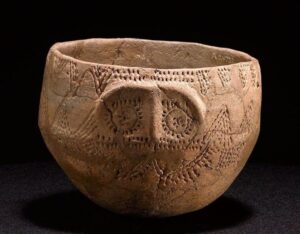In the quiet countryside of Denmark, an intriguing artifact from the distant past has captured the imagination of archaeologists and historians alike. This mysterious relic, known as the ‘Face Pot’, offers a tantalizing glimpse into the cultural practices and beliefs of the Funnel Beaker people who thrived in this region around 3000 BC.
Discovered during an excavation in 1908 at a site called Månehøj, or “Moon Mound”, the ‘Face Pot’ is a ceramic vessel that stands apart from the typical pottery of the Funnel Beaker Culture. What makes this artifact so captivating is its distinctive face-like motif – two piercing eyes and arched eyebrows that seem to stare out from the sides of the pot, creating an enigmatic and almost otherworldly impression.
The Funnel Beaker Culture, named for the characteristic funnel-shaped tops of their ceramics, beakers, and amphorae, flourished in what is now Denmark and parts of northern Germany during the Neolithic period. This sophisticated society is known for its impressive megalithic tombs, intricate pottery, and the development of agricultural practices. The ‘Face Pot’ stands as a remarkable example of their artistic and technological prowess.
Deciphering the Symbolic Meaning
So what was the purpose and significance of this intriguing artifact? Scholars have proposed various interpretations over the years, each offering a unique perspective on the symbolic meaning behind the ‘Face Pot’.
One theory suggests that the face motif may have represented the worship of a great Mother Goddess, a common theme in many Neolithic cultures. The eyes and eyebrows could have been symbolic representations of this divine feminine figure, perhaps playing a central role in the religious beliefs and rituals of the Funnel Beaker people.

Alternatively, some researchers believe the faces were simply a decorative element, an artistic flourish that added visual interest and character to the ceramic vessel. The Funnel Beaker Culture was known for its sophisticated pottery, and the ‘Face Pot’ may have been one of many creative expressions of their skilled craftspeople.
Another interpretation connects the ‘Face Pot’ to the funerary practices of the Neolithic period. During this time, the deposition of various pottery offerings outside megalithic tombs was a common ritual, potentially serving as a means of honoring the dead or facilitating their passage to the afterlife. The ‘Face Pot’ may have been one such offering, its enigmatic gaze symbolizing the connection between the living and the realm of the dead.
Uncovering the Secrets of Neolithic Pottery
The ‘Face Pot’ is not only a captivating artifact but also a valuable source of information about the Funnel Beaker Culture and the broader Neolithic period in Denmark. By studying the pot’s decoration, style, and context, archaeologists have been able to glean insights into the artistic, technological, and cultural practices of this ancient society.
The ‘Face Pot’ is decorated in the Bundsø style, which emerged around 3000 BC and is characterized by intricate geometric patterns and motifs. This style of pottery decoration, along with the custom of pottery offerings at megalithic tombs, provides clues about the rituals and beliefs that were central to the Funnel Beaker people.
Furthermore, the discovery of the ‘Face Pot’ at the Månehøj site, also known as “Moon Mound”, suggests that this location may have held special significance for the Funnel Beaker Culture. The name itself evokes a connection to celestial phenomena, hinting at the possible astronomical or cosmological importance of the site.
The Enduring Legacy of the ‘Face Pot’

The ‘Face Pot’ stands as a testament to the artistic and cultural sophistication of the Funnel Beaker people, who thrived in Denmark thousands of years ago. This enigmatic artifact continues to captivate and intrigue scholars, offering a tantalizing glimpse into the beliefs, practices, and worldview of our Neolithic ancestors.
As we delve deeper into the mysteries of the ‘Face Pot’, we are reminded of the enduring power of art and material culture to convey the rich tapestry of human experience across the vast expanse of time. This remarkable ceramic vessel, with its haunting gaze and enigmatic symbolism, invites us to ponder the shared humanity that connects us to the Neolithic world, and to marvel at the ingenuity and creativity of our forebears.
Whether the ‘Face Pot’ represents the worship of a divine feminine figure, a decorative flourish, or a funerary offering, it remains a profound and thought-provoking relic from the distant past. Its continued study and preservation ensure that the stories and secrets of the Funnel Beaker Culture will continue to captivate and inspire generations to come.
